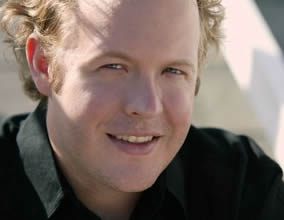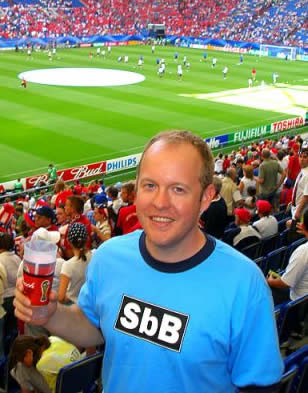
Drew Curtis, the owner of Fark.com, generates 1.5M – 2M page views per day out of his house, all via public relations. I asked Drew a lot about how he monetizes Fark, and he gave some pretty interesting answers.
Full Interview Audio and Transcript
Fast Track Interview
Adrian Bye: I’m here today with Drew Curtis, the sole owner of Fark.com. An interesting thing about Drew and his site is the volume of traffic he gets, running the site pretty much by himself. Drew, tell us about the site. You drive your traffic volume from your house in Kentucky mainly by public relations, right?
Drew Curtis: That’s right. My site is called a news aggregator. I keep telling people we’re Web 3.0, which is just good editing. I was more than happy to let people continue to call us a blog, but we’re not a blog. We’re up to 52 or 53 million page views in the last 30 days, 25% higher than last year. Uniques are about 3.25 million per month.
Adrian Bye: How did you get started, how did your traffic volume grow and how do you keep it going? Promoting a website entirely through public relations is rather unusual.
Drew Curtis: It started out when I would find the occasional funny news stories and e-mail it to my friends. After a while, I thought they might be getting annoyed by all the e-mails so I decided I’ll put them on a website, and if they were still interested, they could continue reading on the website.
It was a combination of publicity and not sucking. Every Friday for 1-1/2 years, I was interviewed about the three weirdest tech-oriented stories of the week on TechTV. On weeks I did TechTV, traffic would rise slightly. When I didn’t, it would remain flat. Over time, we gained viewers, but it wasn’t clear how many. I think it was the consistency of doing it non-stop.
Adrian Bye: If you stop doing interviews will your traffic slowly decline?
Drew Curtis: I doubt it. We noticed in order to lose readers, you have to actively irritate them. As long as you keep the quality up, you’re not going to lose them. We’re probably still gaining through word-of-mouth publicity.
Adrian Bye: Can you quantify the increase in traffic when you were running TechTV?
Drew Curtis: I can’t tell any appreciable difference in traffic from when we were initially doing TechTV. Now that I’ve been mentioned in Time magazine 2-3 times we guess that a single article probably generates 10,000 page views, but we don’t notice anymore since our daily pageviews rotates from between 1.8 to 2.1 million.
Adrian Bye: At what point did you realize that PR was working to drive traffic to your website?
 Drew Curtis: I accidentally ended up doing a classic branding approach. I did TechTV for a year before we noticed it was working. Today a 5-minute spot on CNN at any given time works out a lot better than any advertising because people generally ignore advertising but they don’t ignore news.
Drew Curtis: I accidentally ended up doing a classic branding approach. I did TechTV for a year before we noticed it was working. Today a 5-minute spot on CNN at any given time works out a lot better than any advertising because people generally ignore advertising but they don’t ignore news.
Adrian Bye: I’m looking at your Alexa rank. Today it’s at 2,157. 1½ years ago, your Alexa rank was about 800. Back then, you were getting about a million page views a day. Now, you’re on 2 million a day.
Drew Curtis: It’s bizarre; our Alexa’s been going down steadily considering our traffic keeps going up. Alexa is not a scientific tool. It doesn’t make sense that they’re that different. I don’t know how they’re tracking it.
The explosive growth in the social networking sector is because it generates a phenomenal amount of page views. When you take away everything else, at the end of the day, that’s what’s driving the interest – lots of pageviews. They’re selling ads based on the thousand page view model.
On Fark our average reader reads about two pages, while on Facebook, a user will go through about 100 of them; the same user, same stuff. It’s interesting that ComScore has recently made a significant change in the way they rank sites, doing it based on time per page, not number of page views. The minute that change went through, all of a sudden Facebook went from having a separate page for “how do you know this person” to a drop down box to accomplish the same action more quickly.
Adrian Bye: Interesting! I was looking through some magazines the other day. To get to the table of contents, I had to flick through 6 pages of ads. It wasn’t even clear where it was, it was buried. I found it interesting that the same business model is applied online, adapted to the internet.
Drew Curtis: Yes, exactly.
Adrian Bye: Monetization is an interesting part of your site – you’ve been working with Federated Media in the past, and now Maxim Magazine.
Drew Curtis: Federated Media is basically an outsourced sales group. They do a pretty good job. We’ve moved away from them in recent years due to something they call channel conflict. We were approached by Maxim Magazine, we are their sole client, and it’s a much better deal. The drawback with Federated Media is that they have a number of other clients, so getting their attention is difficult. With Maxim, they go out and get the branded advertising which is only pay for a thousand impressions. No pay-per-click, no pay-per-performance, just straight up page views.
Adrian Bye: Have the checks gotten bigger since you’ve been working with Maxim?
 Drew Curtis: It’s finally starting to get there. The challenge of working with Maxim for the first 15 months was convincing advertisers that it will work, it will perform, and nobody’s going to fire the person making the buying decision, most importantly. We had to build the brand up so that when they think Maxim, they think Fark. Then advertisers try to do some sample buys to test the waters before they start putting more money. We’re at that sampling stage now but it’s encouraging because it’s definitely picking up.
Drew Curtis: It’s finally starting to get there. The challenge of working with Maxim for the first 15 months was convincing advertisers that it will work, it will perform, and nobody’s going to fire the person making the buying decision, most importantly. We had to build the brand up so that when they think Maxim, they think Fark. Then advertisers try to do some sample buys to test the waters before they start putting more money. We’re at that sampling stage now but it’s encouraging because it’s definitely picking up.
Adrian Bye: What percentage of your advertising volume is CPM and what do you fill out with remnant inventory?
Drew Curtis: We probably fill 80-90% remnant at this stage. Having remnant guys running is no big deal provided it’s quality remnant. I forget who it is we’re using, but we get direct from them, about 10-15 million impressions a month. The rest backfills with Google AdSense, which does horrible on Fark.
Adrian Bye: So, you have 10-20% of branded advertising being sold out for you by Maxim, another 70% being sold on a CPM basis at about $0.50 through a CPM remnant network, and the last part is filled in by Google AdSense.
Drew Curtis: That 70% is a breakdown between remnants and Google AdSense. The ratio changes month to month.
Adrian Bye: Interesting. Can you talk about where the overall revenue comes from on your site? You have TOTALFARK, a subscription service. You have CPM advertising through Maxim. You have the CPM remnant inventory. You have Google AdSense and you also have the Google search bar. You have four independent revenue streams. Can you talk about the numbers they generate?
Drew Curtis: What I do know is that the TOTALFARK money is enough to have carried us through to 2006 when we had no advertising. That’s our baseline-keep-the-lights-on money. The rest of it does pretty well. In any business, you want to have as many revenue streams as possible.
Adrian Bye: The book is obviously a new revenue stream for you. I’ve read it and thought it was very funny. Your style of writing is very unusual, it’s a good read. What was the thinking behind the book and how is that impacting the rest of what you’re doing with the site?
Drew Curtis: People say I write like I talk. The initial concept was to write the funniest stories that ever have been on Fark, but I couldn’t get excited about it. I thought about media patterns, how crap news come into play, how the news uses it, what they use it for, when it comes online and when it doesn’t. Any time there’s a major news event, the amount of crap news drops considerably. The worst weeks for garbage news are the weeks before Labor Day and between Christmas and New Year’s because nobody’s working. I worked on finding a whole bunch of patterns to try to classify these articles. The reaction of journalists who read this was they’re blown away by it because the book pretty much nails it. News is just a different form of entertainment, masquerading as something else.
Adrian Bye: The book is called It’s Not News, It’s Fark: How Mass Media Tries to Pass Off Crap as News. It did help me understand more about your site, how it’s working and in general, how your business works. How does the book fit into your overall strategy? You’ve talked about things helping you gain more branding, can you explain that goal and how that works?
 Drew Curtis: News media is set up such that they will always give you time to talk about a book even if they don’t agree with you. I did 350 radio interviews in the first 4 days it was out. I’ve been called in for national news shows to discuss “Has the media gone too far?” to discuss the patterns on what’s happened, where they’ve gone wrong and all that. That’s more promotion. Having my face out in front of people, talking about it, if people like what I have to say but they’ve never heard about me or the website, they’ll go check it out. It’s more of the publicity machine. It’s one of those deals where because it’s an available avenue, you take advantage of it. It’s also an additional revenue stream.
Drew Curtis: News media is set up such that they will always give you time to talk about a book even if they don’t agree with you. I did 350 radio interviews in the first 4 days it was out. I’ve been called in for national news shows to discuss “Has the media gone too far?” to discuss the patterns on what’s happened, where they’ve gone wrong and all that. That’s more promotion. Having my face out in front of people, talking about it, if people like what I have to say but they’ve never heard about me or the website, they’ll go check it out. It’s more of the publicity machine. It’s one of those deals where because it’s an available avenue, you take advantage of it. It’s also an additional revenue stream.
Adrian Bye: Do you think that the book is also a big reason why you’re traffic is up the way it is?
Drew Curtis: Maybe. On Amazon a few reviews have been posted by people that have never heard of the website before. That’s interesting because the whole point is to try to capture an audience of people that haven’t heard of Fark. Maxim estimates about 2 out of 10 people in the United States have heard of Fark, which is absolutely fantastic but it needs to be 8 not 2.
Adrian Bye: Do you have any sales numbers for the book?
Drew Curtis: 25,000 copies in the first 12 weeks, which puts it in the top 1% of all books sold this year.
Adrian Bye: Nice! Well, Drew, thanks for your time.
Drew Curtis: No problem. Thank you.









